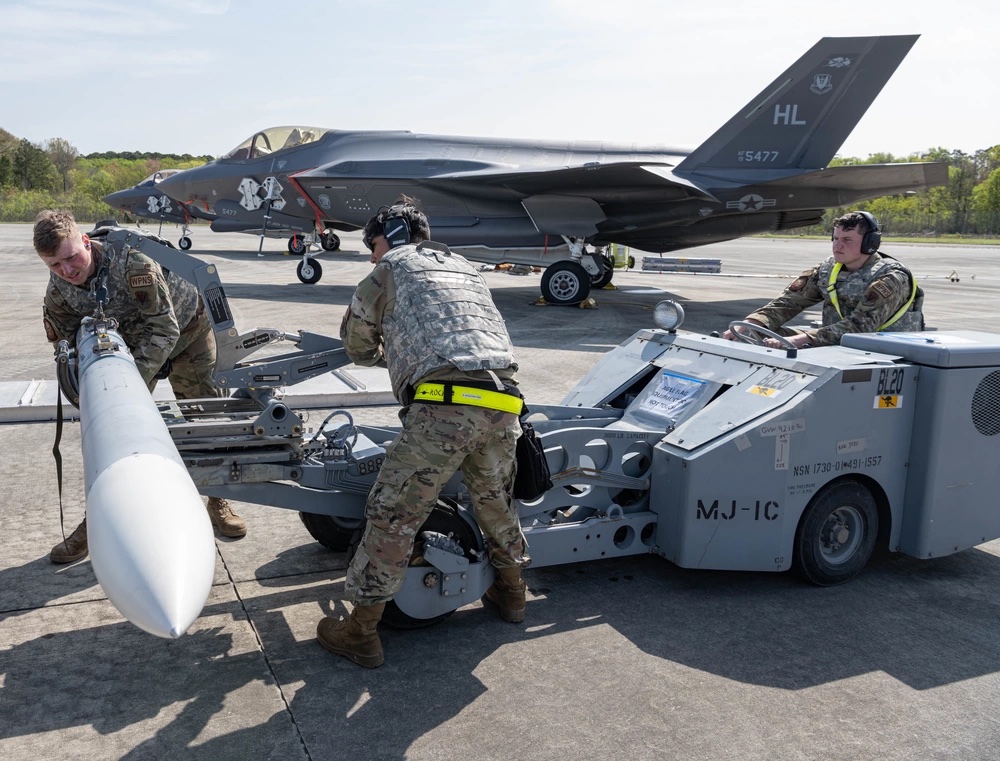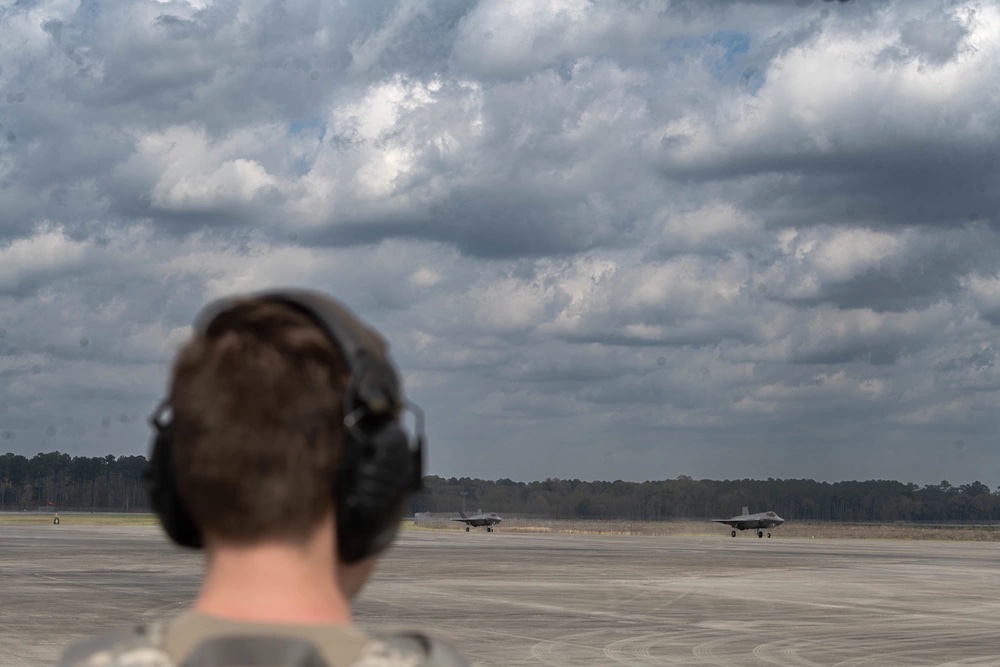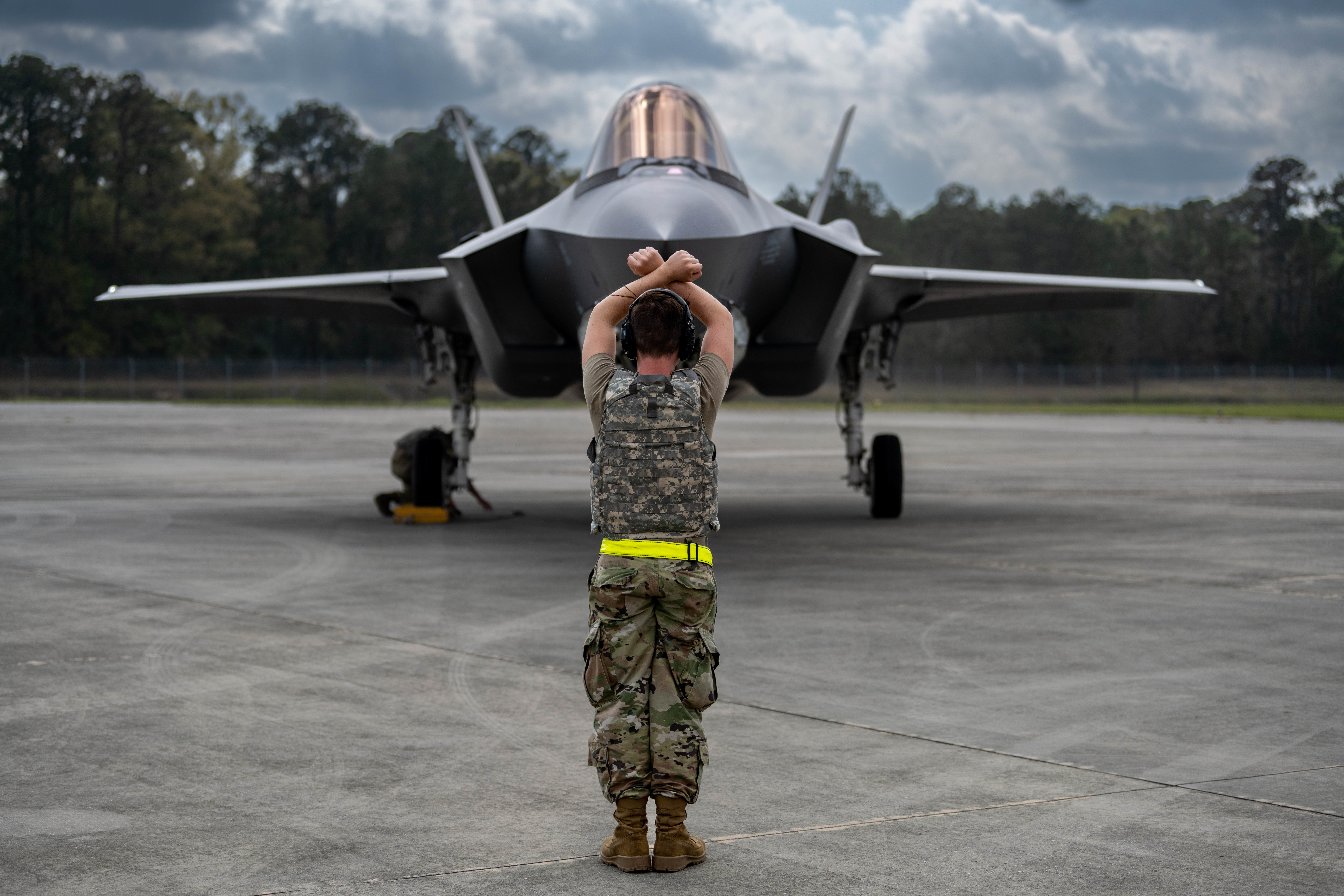HILL AIR FORCE BASE, Utah—Earlier this spring, the 388th Fighter Wing proved just 12 Airmen can operate an F-35 contingency location, refueling and rearming the fighters at spots across Georgia and South Carolina.
The demonstration, part of exercise Agile Flag 23-1, marks yet another proof of concept for the Air Force’s plan to send small teams of Airmen far afield to keep fighter jets running, then pack them up again before moving to another location.
“You can kind of treat a contingency location like a gas station” Maj. Cahn Wadhams, commander of the 4th Fighter Generation Squadron under the 388th, told Air & Space Forces Magazine.
“Jets land, we gas them, we load bombs and then they leave,” he added. “Whatever aircraft lands there, we can get it ready, though we are limited to support just two aircraft at any given time. That is why we’ll set up for a specific set of time, then change location. That is the ‘agile’ piece of Agile Combat Employment.”
Agile Combat Employment (ACE) is the Air Force’s operating concept in which Airmen and aircraft disperse from a central base to smaller, more austere locations in order to complicate an adversary’s targeting—a hub-and-spoke model.
In Agile Flag 23-1, Hunter Army Airfield in Savannah, Ga. acted as the hub, from which the smaller teams of Airmen would depart for contingency locations in Georgia and South Carolina, “turn and burn” aircraft, then return to the hub to resupply before heading out to another location the next day. The contingency teams at Agile Flag 23-1 stayed at each location for 12-hour shifts, but the concept is built to allow teams to operate for multiple days, Wadhams said.
Each contingency location was staffed with 12 maintenance Airmen who served as the mission-generating element of the team, Wadhams explained. Part of the reason why the teams could be so small is the concept of Multi-Capable Airmen (MCA), a key tenet of ACE in which Airmen learn skills outside their usual job specialty.
At Agile Flag, that took the form of Airmen who usually put bombs on aircraft helping direct the planes to launch, or crew chiefs stopping unauthorized personnel on the flight line, something normally done by security forces.
“MCA is designed because of the fact that there is going to be a high rate of attrition if war breaks out,” Wadhams said. “The Air Force needs to have light, agile, and lean forces that are constantly able to move.”

In addition to Airmen learning new skills, ACE requires different kinds of units to work together more closely than ever before. At Agile Flag, that meant maintainers, command and control specialists, and support personnel figuring out how to operate smoothly.
“This was the first time we’ve ever done it, so we expected that,” Wadhams said. “It’s good to see what our constraints are, what we need to fix as we figure out how to fit a mission generation force element into another wing.”
Speed is particularly critical, as these contingency locations will likely operate “in the red zone of where fires and missiles can hit,” said Col. Jeremy Anderson, commander of the 388th Maintenance Group.
“Get the jets back up and back in the fight, but then be ready to defend yourself and survive, and when the C-130 comes, get the heck out of there,” he added. “That’s the whole point, because by now the enemy has figured out exactly where you’re at, and you are about to get attacked. So load up, get out and go to the next spot.”
That mindset is very different from what many maintenance Airmen experienced over the past 20 years, when they stayed “in the rear with the gear” on sprawling bases in the Middle East complete with amenities and fortifications, Anderson said.
“Now it’s ‘get on the C-130, here are your tents, your backpack and MREs, I’m going to plan and come back and get you in a few days, and if any F-35s drop in, gas them, load them and get them the hell out of there,’” he said.
That change introduces logistical questions, and the Air Force is still figuring out what the standard kit might be for a contingency location team, especially if there may be enemy ground troops nearby.
“We’ve got this duck-and-cover mindset where we only throw our protective gear on when we are about to get attacked and then we come back out afterwards to start wrenching on jets,” Anderson said. “If we are worried about folks in the tree line or similar threats, now we need tactical gear that we can wear while we maintain aircraft. Instead of big and bulky you need to be able to move around and be comfortable wearing it for long periods of time.”
Another shift will be the level of responsibility that lower-ranked Airmen will take on. Master sergeants who may not have working communications gear will decide whether or not a partly-broken jet is safe enough to attempt a flight back to higher maintenance care, a decision which is usually left to colonels. Accepting that greater level of risk is a big step for the Air Force maintenance community, which is typically risk-averse, Wadhams explained.
“Now we’re telling our Airmen ‘take more risks, because it is required for mission success,’” he said. “That’s a fine balance that we in the maintenance community have not really cracked and we are trying to figure that out. I think it is just going to take reps and training and getting down in the weeds.”

Luckily, with the greater sense of responsibility, Airmen can also expect greater stability in terms of when they will have to be at peak levels of operational performance. The Air Force is standing up its Air Force Generation Model where units will move together through 6-month phases to prepare for a deployment, get ready for a deployment, deploy, and then reset after a deployment. In the past, the service would cherry-pick individuals or flights for deployments, which could lead to upheaval for some Airmen.
“In the past models, we had a lot of unpredictability and instability in our Airmen’s lives, because you just didn’t know where you were going to go,” said Chief Master Sgt. G Foster, chief enlisted manager for the 388th Maintenance Group. Under AFFORGEN, Airmen will have a better idea of when they will be ready to go, and they know they will go together with their teammates.
The Air Force will have to make smart decisions not just about people, but also about airplanes and equipment. Anderson and Wadhams pointed out that ACE and contingency locations depend on “setting the theater,” which means prepositioning stocks of gas or other supplies so they are available when a contingency location crew arrives.
“The problem is that as soon as you set the theater, the enemy is watching, they are seeing you set the theater, but there is no other way to do it,” Anderson explained. “You balance speed with preparedness. I can go anywhere really fast, but am I going to be able to do anything when I get there? Or do I just drop off a bunch of MREs and tents and bury fuel bladders all over the place so that the enemy does not know which of the 200 places I’m going to use?”
Fighter jets are also limited by the places they can land, since they require fairly smooth, improved surfaces. The Air Force is working through how to “set the theater” while also keeping adversaries guessing, Anderson said.
But even if stocks are prepositioned, there will be the challenge of finding enough transport aircraft to bring teams and equipment to them, Wadhams pointed out.
“Designated airlift is nearly impossible considering the Air Force is also the airlift provider for the Marines and the Army,” he said. Teams may have a transport aircraft for a day, but then the plane has to go pick up someone else in need. Gen. Mike Minihan, the head of Air Mobility Command, is well aware of the challenge.
“As the joint force maneuver, we have to service everybody,” Minihan said in March while discussing his troops’ large-scale exercise, Operation Mobility Guardian, which will take place over the Pacific Ocean this summer.
“Airlift is going to be the biggest struggle,” said Wadhams. “If we don’t have gas, we can’t fly.”

